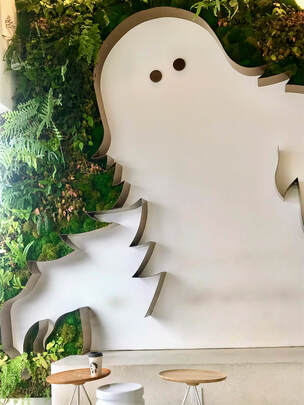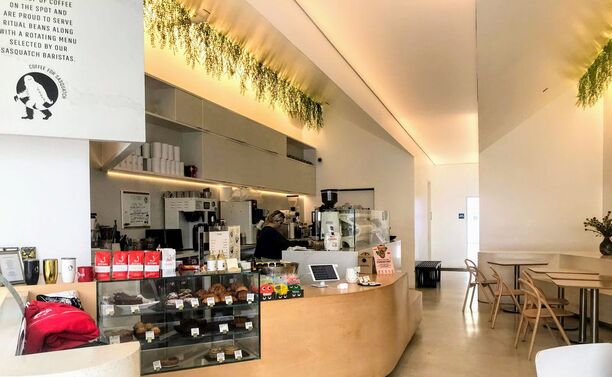 Coffee For Sasquatch in the Melrose District of Los Angeles. Coffee For Sasquatch in the Melrose District of Los Angeles. In the early days of COVID-19, I asked my humble amount of IG followers how their coffee habit had been impacted. About 80% said yes, it had been impacted and they were drinking more coffee as a result. Months later, it was a resounding 100%, and 100% were drinking “more coffee than before the pandemic.” Now obviously my poll is biased, filled with coffee drinkers, long-time caffeine addicts, but market research is showing my poll was not far from the trending truth... A huge part of the “second wave” definition is rooted in cafe culture, or as Howard Shultz coined it, “the third place” (home, work, coffee shop). I personally loved this philosophy and the connection rooted in history when coffee houses were a part of daily life, ingrained in culture because it’s where so many cultures met, merged and educated one another. The third wave is your local “hipster” coffee shop, where quality is always more important than quantity, beans went from just “light/medium/dark” descriptors to: single origin, varietal, processing method, and transparency became more important for the educated coffee consumer (and the “educated” were becoming the “everyday”).
The internet started talking about “fourth wave” coffee in 2019 -- trying to define it, identifying it as “already here” or “coming soon,” opinions on pros and cons -- but an overlooked piece was something no one could predict: the change in cafe culture, largely brought into question now, due to COVID-19. Here are the five ways we can expect to see cafe and coffee culture adapt in the U.S. in 2021, and possibly, beyond: More “walk-up window” coffee shops You may have already experienced this from certain Starbucks locations and metropolitan hubs from LA to Paris, but walk-ups are the new normal for COVID-era coffee lovers. What started as a transformation out of necessity, much like the “ghost kitchen” trend, walk-up hole-in-the-wall coffee shops have a bright future thanks to low overhead, a small staff, built-in COVID precautions (glass partitions) and most importantly, lower rent. Mobile ordering will dominate Drive-thru coffee and mobile ordering have been around for a while now, but it’s another piece of the market that becomes more relevant every day. While I’ve always wondered “who the hell is ordering coffee from Postmates?” I think the answer is… “plenty of people.” Don’t get me wrong, I’m a zombie in the morning, so I see the appeal, except, the reduction in quality is always on my mind (ice melting, hot coffee becoming lukewarm, if your order is wrong you can’t exactly count on the delivery dude to take a sip and say “ew this is caramel, I wanted a vanilla latte,” so on and so forth). As for drive thru, it goes without saying that Starbucks, Dunkin’ and fast food chains have this market cornered, but in certain parts of the U.S., converting a standalone shop to drive-thru may be feasible if the community has a need (commuter-heavy cities). More hybrid-setting coffee shop concepts Indoor/outdoor spaces are the ideal middle-ground for cafes. While I’ve got it made in SoCal with more-or-less predictable year-round sunshine, other areas in the U.S. will have to get more creative with new cafe design, redesign, or scrapping the conventional cafe model altogether. As restaurants go al fresco, the Parisian cafe concept should also expand as space transitions from luxury to necessity. Some of the most walkable metropolitan-regions like Long Beach, CA or the Meatpacking District in NYC have been heading in this direction or were already there, but this is where local government comes into the equation. Location is a huge factor now, outside of cafe model, with residential coffee shops outperforming business-based shops since the beginning of lockdown, for obvious reasons. In the end, those who innovate will succeed. Keeping the status quo will amount to a risky business move, for most. More brand loyalty… or less Some people have gravitated toward the brands they know, buying Starbucks beans at the supermarket or buying Blue Bottle directly from the brand’s website. Others have swung the opposite direction, taking this time at home as an opportunity to taste new brands, roasts, origins and more. The latter half can be extremely beneficial for small businesses, gaining new customers out of curiosity, social media exploration and of course, conscious consumers who seek out small businesses to support. This experiment-friendly population also has cost-conscious consumers; those aware of their dormant expendable income, and those at the other end of the spectrum, who are spending more on basic necessities and less on food, entertainment, etc. The former half are happy to try more expensive specialty coffees, limited or rare lot offerings, sustainably-sourced or fairtrade, etc. While the latter half are suffering from pay cuts, layoffs, or are hyper-aware of their job’s insecurity. More coffee subscriptions From Crema to Panera, brands big and small are embracing the home-delivery system of coffee subscriptions. Consumers are just opening their eyes to all that subscription companies have to offer, like convenience, variety and consistency. Just like the chicken and egg paradox, now that consumers are tiptoeing into coffee subscriptions, more subscription companies are popping up. When I found Crema, I was in the middle of research -- trying all the most popular coffee subscription boxes -- to figure out which company was doing it best. And while I’m not done with my research, as of now, Crema is by far the company to beat. It offers the most customizable experience, seamless UX design, the lowest prices, the best coffee selection and an authenticity so rare and beautiful, that it feels like I’m old friends with the Crema curators. As an ex-barista, Crema delivers everything I want out of a coffee subscription box, and then some. So, I encourage all types of coffee drinkers to look into Crema because I think there truly is something for everyone on the platform. So, is this the end of the “coffee shop”? Quiet refuge for bookworms and writers, first date capital of the world, sanctuary workspace away from work… I sure hope it’s not the end, but merely a forced adaptation. Let’s hope all of the above translates into a fruitful, stabilizing specialty coffee marketplace in the immediate and foreseeable future. Remember to shop small and shop local! Stay healthy + stay caffeinated ~ Cheers, LA CoffeeMate Note: This blog post was not sponsored by Crema.co. I'm just a fan :) This blog post is also a contributed article to Crema's blog, Sunday Sippin'.
3 Comments
2/20/2022 10:02:56 pm
Thank you for sharing informative content. It means a lot to me hope you do more articles to post.
Reply
10/12/2022 01:41:55 pm
I'm glad to say that here in northern Idaho, nothing changed during the CCP virus. We still did business and fun as usual and people caught the flu just like any other year. Additionally, we drank more coffee in 2021, than 2020, and 2019.
Reply
Leave a Reply. |
AuthorFollow me @autumn.enoch 📸 CoffeeMateCoffeeMate is your utilitarian guide to LA coffee shops, dedicated to amplifying small businesses.
CoffeeMate also provides product reviews, lists, 101s and more. My ratings scale is as follows: (5) Balanced (4) Strong (3) Bitter (2) Weak (1) Stale Categories
All
|

 RSS Feed
RSS Feed